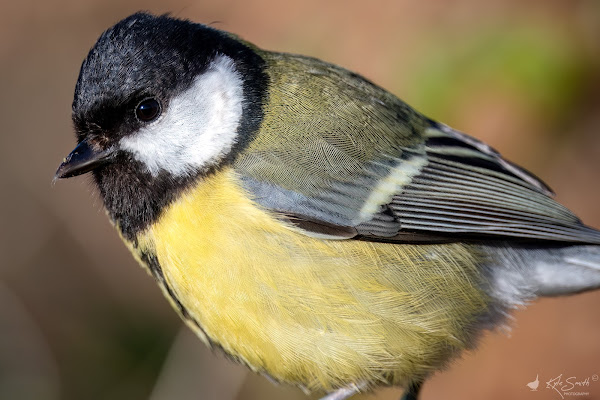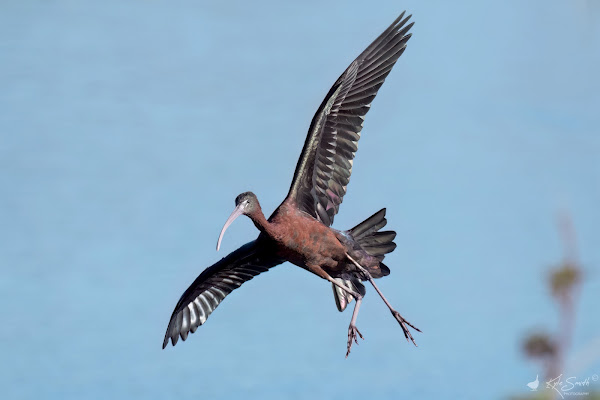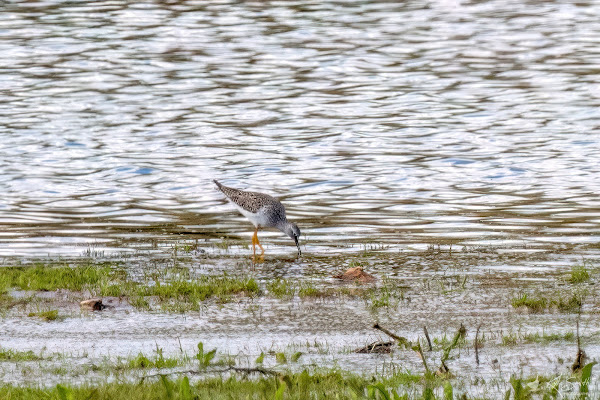We planned for a big day and left at 04.00am to meet Kev's sister Karen (@hobbylovinglife) and her partner Dean (@worlebirder) at RSPB Ham Wall. We arrived not long after 06.00am and ahead of Karen and Dean, although they were not far behind. Suited and booted we entered the reserve and were greeted by calling willow warblers, chiffchaff and three roe deer.
By the time we reached Viewing Point 1 we had already heard a grasshopper warbler reel briefly - but it was not visible, Cetti's warbler could also be heard calling in all directions - such a magical time of the morning. A pair of garganey were out on the edge of the far reeds, with another two drakes way off to our left. Dean then picked out a further pair. A couple of common whitethroats worked along the bank ahead - two new birds for the year already!
As we walked large numbers of sand martins swept across the sky, plus a few swallows and occasional marsh harriers. Bitterns boomed in all directions but didn't give themselves up - we also heard sedge and reed warblers but didn't see these either. At one point Dean connected with a swallow-type bird that appeared to be a candidate for red-rumped swallow, but it was lost and we will just never know.
Returning to the main path we stopped as Karen and Dean stopped to talk to some friends - Kev and I strolled on a bit, and I came across a few showy Cetti's warblers - it is that time of year when they break from their usual skulking behaviour. It wouldn't be the last views we had.
I got a call from Kev who was now further ahead and as I drew level, he said that he'd had a small flock of lesser redpoll to his left and we could still see them in the trees behind. They were making a trilling sound unlike their calls we'd heard before - it was the call that had drawn Kev to them. They flitted back to the trees by us, and we watched on as they fed. Dean and Karen caught up and joined the views, particularly of one male showing intense colouration. A great tit dropped right in front of us and called, seemingly wanting his photo taken.
We returned to Viewing Point 1 and stopped hoping for a bittern flight - I am still waiting to see my first of the year, but it wasn't to be. Karen went to see if any glossy ibis were visible from the gate at the end of the pool but returned empty handed. We saw a pair of marsh harriers chasing one another on the far-left treeline. One of the two whitethroats crossed the water to sing from a tree to our left - a Cetti's was singing from there too. Karen alerted us to a glossy ibis that had taken to the wing out in front of us - it must have been feeding under the bank. It was airborne for only 30s or so, but I managed to shoot off a few photos to capture the moment.
We had enjoyed our time here but had plans to nip across to WWT Steart Marshes as it was not far from Ham Wall - a pectoral sandpiper had been reported there from Tuesday, and had just been reported again. We stopped for breakfast on the way and on arrival made our way to the reported location. We scanned around seeing five yellow wagtails, a handful of little ringed plover and many avocets and shelducks.
We found a sandpiper candidate out in the scrape but is turned out to be a ruff - still it was a year tick for me. The birds on the scrape were flushed and we scanned the sky to see if we could find a raptor - on this occasion we could, a sparrowhawk. Still no sandpiper though …
We found a couple of wheatear on the very far bank and a single curlew called in front. We got talking to a chap perched on the edge of the screen - he informed us that the sandpiper had taken to the wing some time ago, but crucially he could tell us roughly where it had flown to. We were looking in the wrong area. Armed with this new intel we could focus our attention in the right area and within minutes Dean and I were on the bird - Dean with the advantage of viewing through a scope. We investigated the bird and were happy that it was our target. The heat haze and distance made it damn-near impossible to get even a record shot.
We discussed what to do next - we could easily spend the rest of the day here but decided that the offer of a lesser yellowlegs at the Otter Estuary NR was too good to turn down.
On arrival we managed to find spaces in a very busy car park - people were out in force, enjoying the sunny and warm conditions. We paid for parking and set off to the published location - Kev had been here before and so knew the lay of the land. We met a birder coming the other way and he took pleasure in following back with us to show where the bird was - we were on it easily but it was a nice touch. It had apparently stayed very distant all morning and that didn't change.
To to begin with the legs were far from 'yellow' as they were coated with mud but soon enough it stalked through the shallows and the leg colour and length became evident. We found the narrow path we were standing on a bit of an issue with people wanting to get by, particularly difficult if you were using a tripod - hopefully this won't be an issue for the site longer term. From the various viewing points the site it easier to survey, but even here the viewing slots are not positioned to let scopes see through unhindered - at the wrong height - the screens are far from the action and so the use of scopes will be necessary. Karen and I took some photos while Kev took some video.
Dean stayed put while Kev, Karen and I walked down to the bridge and back - we had a couple of late wigeon while Dean added a green sandpiper to his day's sightings. It was now time to set off for home - it would take at least three hours from here. Dean and Karen would look out on the beach and find six sandwich terns, then add Dartford warblers on the way home.
Year List: 195.





















No comments:
Post a Comment